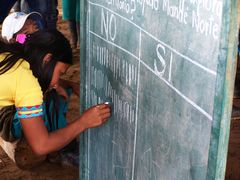
During the People’s Consultation 12 indigenous communities rejected the exploration and exploitation of the Careperro Mountain.
article published in the Newsletter ColomPBIa No. 11, May 2009:
Indigenous peoples reject mining project[1]
Between 24 and 28 February, 12 indigenous communities from the territories of Uradá, the Jiguamiandó river, the Chageradó-Turriquitadó river, and the Murindó river, and afro-descendents from the Pueblo Nuevo Humanitarian Zone in the Jiguamiandó river basin, held an event to strengthen their autonomy, by expressing their opinions about the implementation of the Mandé Norte project in their lands. The response to the event was strong, and the communities unanimously rejected the project.
What is the Mandé Norte project?
The Muriel Mining Corporation obtained permits from the Colombian government to exploit minerals in the geographic area which includes lands in the municipalities of Vigía del Fuerte, Urrao, Frontino, Mutatá, Dabeiba, Murindó, and Carmen del Darién, forming the Mandé Norte large-scale development project.[2] According to investigative journalist and writer Alfredo Molano Bravo, this project is “one of the most destructive, predatory and arbitrary projects in the Chocó region.”[3] For the Embera-Katío People, the Careperro Mountain, situated within the area where the project is located, is one of the most sacred places in their culture. “It is the place of ecological balance between human beings and good or bad spirits in the Embera cosmovision. It is the botanical centre where medicinal plants are concentrated, the pharmacy for traditional doctors, and our knowledge itself.”[4] The Indigenous Organisation of Antioquia (OIA) declares that by exploring and exploiting traditional lands in this way, this sacred place will be desecrated. The communities affected by the Mandé Norte Project confirmed that there had been no process of prior consultation, and that when there had been a process, it had been carried out in a fraudulent manner. “They invited a few leaders to the meetings, they gave them alcohol and food, but they never talked to them about the exploration they were going to carry out. For the Government, this process was valid, and they have already started the exploration process,” said Yagarí,”[5] member of the OIA. These 12 communities also rejected the agreements signed between the company and CAMIZBA, the Indigenous Authority from the Lower Atrato region, and CAMICAD, the Indigenous Authority from Carmen del Darién.
For these reasons, the affected communities decided to hold their own consultation process to answer the question “Do we want the mining exploration and exploitation Mandé Norte Project to be implemented in our lands?” Prior consultation with indigenous and afro-descendent communities in relation to projects planned for implementation in their lands is established in article 330 of the Colombian Constitution, and in Convention 169 of 1989 from the International Labour Office, ratified in Colombia under Law 21 of 1991. According to the Attorney General´s Office, “prior consultation is designed to ensure that the rights of indigenous peoples and afro-descendents to their lands are respected, as well as the protection of their natural resources and cultural social and economic rights, as a guarantee of their existence.”[6] In this case, the peoples’ consultation was carried out with the accompaniment of international delegates and members of indigenous peoples and afro-descendent communities from other areas of the country, as well as national organisations. PBI attended at the request of the Inter-Church Justice and Peace Commission (CIJP), who agreed to accompany the Embera community in the region .[7]
The Peoples’ Consultation began with homage to the Mother Earth. More than 1000 indigenous people met in Coredocito with the aim of making their voices heard. On that day, 25 February, around 800 voted unanimously in opposition to the Mandé Norte Project. Afterwards the participants travelled to areas which have already been deforested, “one where the company`s technical camp is situated (…) and another where the military have been installed to protect the interests of the company.” [8] In these places, ceremonies were held to reconcile the spirits, and to protect the Mountain. Afterwards a second day of voting was held in the afro-descendent community of Pueblo Nuevo where more than 280 people voted against the project. According to Oscar Ayala, an observer from Paraguay, “those who participated had a clear understanding of the aims of the consultation, which is an important strengthening of this grassroots consultation, and shows the communities´ autonomy.”[9]
Now the issue will be dealt with at the legal level, and the CIJP is looking into the possibility of some organisations supporting the communities in their decision to defend their lands, protect their ecosystems, and their survival as peoples.[10]
[1] The title comes from the article: “Colombia: No a la Minería en territorio indígena”, Salva la Tierra, 5 March 2009
[2] “El proyecto Mandé Norte desde la visión del Emberá”, Periferia Prensa Alternativa, 19 March 2009
[3] “La socia Mandé Norte” (Alfredo Molano´s column), El Espectador, 24 January 2009
[4] “OIA: Consulta interna para defender el territorio”, Indigenous Organisation of Antioquia, 18 March 2009
[5] “Proyecto ‘Mande Norte’ genera tensión en pueblos indígenas de Antioquia”, Press Agency of the Popular Training Institute, 26 January 2009
[6] “Las minorías étnicas” (Columna de opinión de Manuel Rodríguez Becerra , El Tiempo , 6 April 2009
[7] “Declaración pública indígenas resguardos Uradá, Jiguamiandó, Chageradó, Tirriquitadó y Río Murindó”, March 2009
[8] “Colombia: No a la Minería en territorio indígena”, Salva la Tierra, 5 March 2009
[9] Ibid
[10] “DeVer 504 – Revisión de Tutela por Cerro Ellausakirandarra propicia apoyo por causa indígena y afro”, CIJP, 27 March 2009
